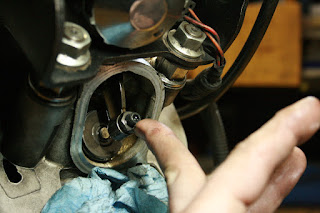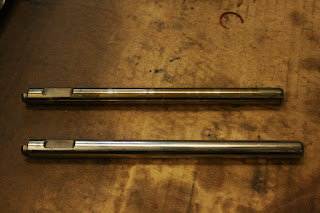Last time we left, when the engine was on the bench and the obvious next step is to put it in a frame and squeeze some happy sounds out of it. But in order to put something in said frame, a bit of taking stuff out of the same was due.
Only a few hours later and my workshop is a proper mess.
The reasosn for this taking so long were plentiful, amongst some others, new starter cables had to be made and some new connectors had to be crimped onto the wiring. (Have ever pointed out, that a nicely crimped connector can be a thing of beauty?)
The starter motor cable was crimped and soldered to ensure the best contact possible.
... and as by magic, the new engine is in the frame and filled with oil.
During the course of action, I also finally found out, why there always was a bit of fine rust-powder in one of my carbs: the glue of the filter had decided to call it quits, as can also be seen by the little flake of glue at the end of the filter.
At this point, things went "slightly" sideways, as in the starter, which had worked just fine, before the engine was set aside... well it didn't anymore. Of course you work this out AFTER you fill the engine with oil.
Oh and as it turned out, that new starter had a slightly oversized shaft, which had to be polished with some emery paper to get it down by about 0.15mm to make the starter clutch slide on and off the shaft without force.
And guess what: Press the button and fire the old girl up. Just like that.
But the story doesn't end on the note of "just like that". What you see here is a spark plug that had a very unfortunate first date with bits of piston and valve.
And a bit of valve stem, which sports a slightly dramatic valve clearance setup.
Alright, so we're dealing with a bent valve. No big deal, right?
Uh oh. Bits of piston stuck inside the carburettor.
Now those engine bits in the inlet are less of a surprise already, if I am being honest.
No point in not digging into the engine and taking of the offending head.
The way the valve stem is fractured is interesting. This very coarse grainy structure leads me to belive, that it had broken away? Also the stem is incredibly brittle, so there might have been some heat involved?
Now, I was still looking for two valve-dishes...
Remarkably, the piston held up nicely, regardless of a huge, gaping hole in the middle, the skirt's virtually undamaged.
Quite a bit of said piston luckily made it out through the exhaust.
And now to a practical example of what "Zweckoptimismus" is: Looks like the conrod and crankshaft survived, unless the other side with the primary drive gears took a hit.
The cylinder (some actual measurements pending) could be good enough for a 3rd oversize, i.e. +1.00mm bore. As it has taken some damage, but all the dings don't seem to be very deep, there might be a chance of getting away with it.
All in all, there's still a lot of investigation due and I suspect, it'll be best to put a blanket over this engine for a few days and then have another (more calm) look over it and assess the damage. Maybe at least some parts of the heads (aside from the covers, etc.) can be re-used.























































